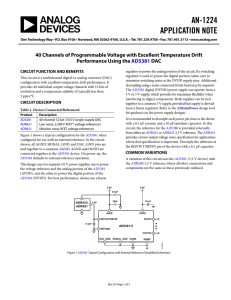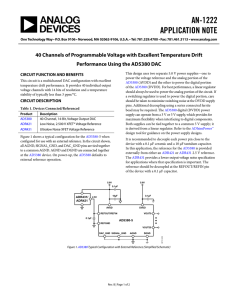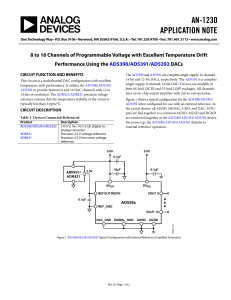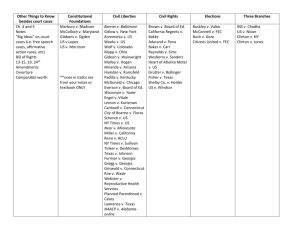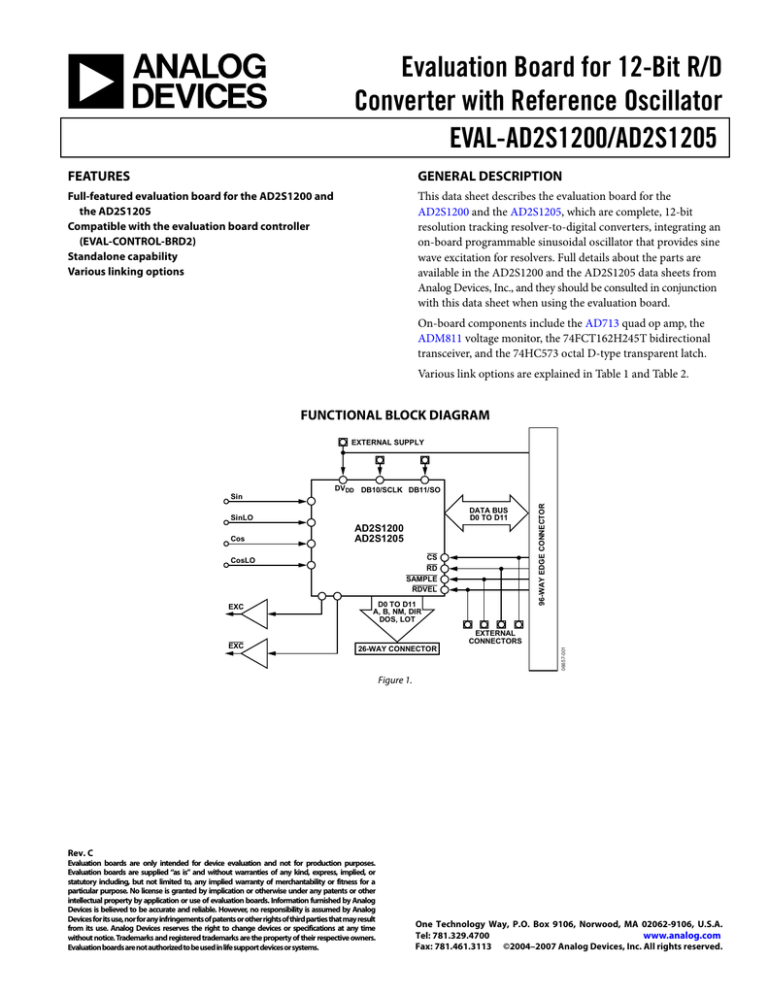
Evaluation Board for 12-Bit R/D
Converter with Reference Oscillator
EVAL-AD2S1200/AD2S1205
FEATURES
GENERAL DESCRIPTION
Full-featured evaluation board for the AD2S1200 and
the AD2S1205
Compatible with the evaluation board controller
(EVAL-CONTROL-BRD2)
Standalone capability
Various linking options
This data sheet describes the evaluation board for the
AD2S1200 and the AD2S1205, which are complete, 12-bit
resolution tracking resolver-to-digital converters, integrating an
on-board programmable sinusoidal oscillator that provides sine
wave excitation for resolvers. Full details about the parts are
available in the AD2S1200 and the AD2S1205 data sheets from
Analog Devices, Inc., and they should be consulted in conjunction
with this data sheet when using the evaluation board.
On-board components include the AD713 quad op amp, the
ADM811 voltage monitor, the 74FCT162H245T bidirectional
transceiver, and the 74HC573 octal D-type transparent latch.
Various link options are explained in Table 1 and Table 2.
FUNCTIONAL BLOCK DIAGRAM
EXTERNAL SUPPLY
DVDD DB10/SCLK DB11/SO
DATA BUS
D0 TO D11
SinLO
AD2S1200
AD2S1205
CS
RD
SAMPLE
RDVEL
CosLO
EXC
D0 TO D11
A, B, NM, DIR
DOS, LOT
EXC
26-WAY CONNECTOR
EXTERNAL
CONNECTORS
06657-001
Cos
96-WAY EDGE CONNECTOR
Sin
Figure 1.
Rev. C
Evaluation boards are only intended for device evaluation and not for production purposes.
Evaluation boards are supplied “as is” and without warranties of any kind, express, implied, or
statutory including, but not limited to, any implied warranty of merchantability or fitness for a
particular purpose. No license is granted by implication or otherwise under any patents or other
intellectual property by application or use of evaluation boards. Information furnished by Analog
Devices is believed to be accurate and reliable. However, no responsibility is assumed by Analog
Devices for its use, nor for any infringements of patents or other rights of third parties that may result
from its use. Analog Devices reserves the right to change devices or specifications at any time
without notice. Trademarks and registered trademarks are the property of their respective owners.
Evaluation boards are not authorized to be used in life support devices or systems.
One Technology Way, P.O. Box 9106, Norwood, MA 02062-9106, U.S.A.
Tel: 781.329.4700
www.analog.com
Fax: 781.461.3113 ©2004–2007 Analog Devices, Inc. All rights reserved.
EVAL-AD2S1200/AD2S1205
TABLE OF CONTENTS
Features .............................................................................................. 1
Operating with the Evaluation Board Controller .....................6
General Description ......................................................................... 1
Evaluation Board Software...............................................................7
Functional Block Diagram .............................................................. 1
Installing the Software ..................................................................7
Revision History ............................................................................... 2
Software Description ....................................................................7
Evaluation Board Hardware ............................................................ 3
Setting Up the EVAL-CONTOL-BRD2 .....................................9
Power Supplies .............................................................................. 3
Evaluation Board Schematics and Artwork................................ 10
Link Options ................................................................................. 3
Ordering Information.................................................................... 15
Setup Conditions .......................................................................... 4
Bill of Materials........................................................................... 15
Evaluation Board Interfacing...................................................... 5
Ordering Guide .......................................................................... 16
Sockets ........................................................................................... 6
ESD Caution................................................................................ 16
Connectors .................................................................................... 6
REVISION HISTORY
6/07—Rev. B to Rev. C
11/05—Rev. 0 to Rev. A
Updated Format..................................................................Universal
Replaced Introduction ..................................................................... 1
Changes to Evaluation Board Interfacing Section ....................... 5
Changes to Bill of Materials .......................................................... 15
Added Evaluation Board Schematics and Artwork ................... 10
Added Bill of Materials .................................................................. 14
5/04—Revision 0: Initial Revision
11/06—Rev. A to Rev. B
Added EVAL-AD2S1205 ...................................................Universal
Rev. C | Page 2 of 16
EVAL-AD2S1200/AD2S1205
EVALUATION BOARD HARDWARE
POWER SUPPLIES
When using the EVAL-AD2S1200/AD2S1205 with the evaluation
board controller, all supplies are provided from the controller
board through the 96-way connector.
When using the board as a standalone unit, external supplies
must be provided. This evaluation board has the following six
power supply inputs:
•
•
•
•
•
•
AVDD
DVDD
+15 V
−15 V
AGND
DGND
74FCT162H245T, and the 74HC573. To supply the regulators
that provide power to the AD713 quad op-amp, +15 V and
−15 V should be used. Lastly, 0 V is connected to one or both of
the AGND inputs and to the DGND input.
The AVDD and DVDD supplies are decoupled to the relevant
ground plane with 4.7 μF tantalum and 0.1 μF multilayer
ceramic capacitors. The AD713, the 74FCT162H245T, and the
74HC573 are decoupled to the relevant ground plane with
10 μF tantalum and 0.1 μF multilayer ceramic capacitors.
Extensive ground planes are used on this board to minimize
the effect of high frequency noise interference. There are two
ground planes, AGND and DGND. These are connected at one
location close to the AD2S1200/AD2S1205.
LINK OPTIONS
If the evaluation board is used in standalone mode, 5 V must be
connected to the AVDD input to supply the AD2S1200/AD2S1205
AVDD pin. In addition, 5 V must be connected to the DVDD
input to supply the AD2S1200/AD2S1205 DVDD pin, the
There are 14 link options that must be positioned for the
required operating setup before using the evaluation board. The
functions of these options are outlined in Table 1.
Table 1. Link Option Functions
Link No.
LK1
Function
This link selects the source of the RD input signal for the AD2S1200/AD2S1205.
In Position A, the RD signal is taken from the externally applied RD signal via the J12 SMB socket or the J10 connector.
In Position B, the RD signal is taken from the evaluation board controller via the 96-way connector.
In Position C, the RD signal is taken from the S3 push button switch.
LK2
This link selects the source of the CS input signal for the AD2S1200/AD2S1205.
In Position A, the CS signal is taken from the externally applied CS signal via the J11 SMB socket or the J10 connector.
In Position B, the CS signal is taken from the evaluation board controller via the 96-way connector.
In Position C, the CS signal is taken from the S3 push button switch.
LK3
This link selects the source of the SAMPLE input signal for the AD2S1200/AD2S1205.
In Position A, the SAMPLE signal is taken from the externally applied SAMPLE signal via the J9 SMB socket or the J10 connector.
In Position B, the SAMPLE signal is taken from the evaluation board controller via the 96-way connector.
In Position C, the SAMPLE signal is taken from the S2 push button switch.
LK4
This link selects the source of the RDVEL input signal for the AD2S1200/AD2S1205.
In Position A, the RDVEL signal is taken from the externally applied RDVEL signal via the J4 SMB socket or the J10 connector.
In Position B, the RDVEL signal is taken from the evaluation board controller via the 96-way connector.
In Position C, the RDVEL signal is tied to AVDD.
In Position D, the RDVEL signal is tied to AGND.
LK5
LK6
This link connects the externally applied SCLK via the J13 SMB socket to the AD2S1200/AD2S1205.
This link selects the source of the SOE input signal for the AD2S1200/AD2S1205.
In Position A, the SOE signal is tied to AVDD (parallel mode).
In Position B, the SOE signal is tied to AGND (serial mode).
LK7
This link selects the frequency of the sinusoidal excitation signals, the EXC and EXC pins of AD2S1200/AD2S1205.
The frequency of this reference signal is programmable to four standard frequencies (10 kHz, 12 kHz, 15 kHz, or 20 kHz)
using the FS1 and FS2 pins. FS1 and FS2 have internal pull-ups so the default frequency is 10 kHz.
In Position A, the FS2 signal is tied to AGND.
In Position B, the FS1 signal is tied to AGND.
Rev. C | Page 3 of 16
EVAL-AD2S1200/AD2S1205
Link No.
LK8, LK9
LK10
LK11
LK12
LK13
LK14
Function
These links select the gain of the EXC and EXC amplifier circuits.
In Position A, the gain can be set by the user. Gain = R/10 kΩ where R = R1 = R4.
In Position B, a gain of 1.8 is applied.
In Position C, a unity gain is applied.
This link is used to select the source of the AVDD supply for the EVAL-AD2S1200/AD2S1205.
In Position A, the AVDD supply is sourced from the evaluation board controller via the 96-way connector.
In Position B, the AVDD supply is sourced externally via the J6 connector.
This link is used to select the source of the +15 V supply for the EVAL-AD2S1200/AD2S1205.
In Position A, the +15 V supply is sourced from the evaluation board controller via the 96-way connector.
In Position B, the +15 V supply is sourced externally via the J8 connector.
This link is used to select the source of the DVDD supply for the EVAL-AD2S1200/AD2S1205.
In Position A, the DVDD supply is sourced from the evaluation board controller via the 96-way connector.
In Position B, the DVDD supply is sourced externally via the J7 connector.
This link is used to select the source of the −15 V supply for the EVAL-AD2S1200/AD2S1205.
In Position A, the −15 V supply is sourced from the evaluation board controller via the 96-way connector.
In Position B, the −15 V supply is sourced externally via the J8 connector.
This link is used to select the source of the enable inputs of the 74FCT162H245T.
In Position A, the enable inputs are sourced from the CS input to the AD2S1200/AD2S1205.
In Position B, the enable inputs are sourced from the inverse of the SOE input to the AD2S1200/AD2S1205.
SETUP CONDITIONS
Care should be taken before applying power and signals to the evaluation board to ensure that all link positions are as per the required
operating mode. Table 2 shows the position where all links are set when the evaluation board is packaged.
Table 2. Initial Link Positions
Link No.
LK1
LK2
LK3
LK4
LK5
LK6
LK7
LK8, LK9
LK10
LK11
LK12
LK13
LK14
Position
B
B
B
B
No Connect
A
No Connect
B
A
A
A
A
A
Function
RD is supplied from the evaluation board controller.
CS is supplied from the evaluation board controller.
SAMPLE is supplied from the evaluation board controller.
RDVEL is supplied from the evaluation board controller.
Parallel mode of the AD2S1200/AD2S1205 is selected.
Default reference signal frequency of 10 kHz is selected.
Gain mode of 1.8 is selected.
AVDD is supplied from the evaluation board controller.
+15 V is supplied from the evaluation board controller.
DVDD is supplied from the evaluation board controller.
−15 V is supplied from the evaluation board controller.
The enable signal for the 74FCT162H245T is sourced from the CS signal to the AD2S1200/AD2S1205.
Rev. C | Page 4 of 16
EVAL-AD2S1200/AD2S1205
1
Interfacing to the evaluation board is via a 96-way connector,
J1. J1 is used to connect the EVAL-AD2S1200/AD2S1205 to
the EVAL-CONTROL BRD2 or another system. The pinout
for the J1 connector is shown in Figure 2. Table 3 describes
the pins on the 96-way connector used to interface between the
EVAL-CONTROL-BRD2 and the EVAL-AD2S1200/AD2S1205.
Table 4 gives its pin designations and functions.
8
16
24
32
8
16
24
32
A
B
C
1
Figure 2. Pin Configuration for the 96-Way Connector, J1
Table 3. 96-Way Connector Pin Description
Table 4. 96-Way Connector Pin Functions1
Pin
D0 to D11
Pin No.
1
2
3
4
5
6
7
8
9
10
11
12
13
14
15
16
17
18
19
20
21
22
23
24
25
26
27
28
29
30
31
32
RD
CS
FL0
FL1
AGND
DGND
AVDD
DVDD
−12 V/−15 V1
+12 V/+15 V1
1
Description
Data Bit 0 to Data Bit 11. Three-state TTL outputs;
D11 is the MSB.
Read. This is an active low logic input connected
to the RD pin of the AD2S1200/AD2S1205 via
LK1. The falling edge of RD transfers data to the
output buffer.
Chip Select. This is an active low logic input
connected to the CS pin of the AD2S1200/
AD2S1205 via LK2. The device is enabled when
CS is held low.
Flag Out 0. This pin is used to generate the
SAMPLE pulse to initiate data transfer from the
position and velocity integrators to the position
and velocity registers.
Flag Out 1. This pin is used to provide the RDVEL
signal from the DSP to the AD2S1200/AD2S1205.
Analog Ground. These lines are connected to the
analog ground plane on the evaluation board.
Digital Ground. These lines are connected to the
digital ground plane on the evaluation board.
Analog +5 V Supply. These lines are connected to
the AVDD supply line on the board via LK10.
Digital +5 V Supply. These lines are connected to
the DVDD supply line on the board via LK12.
−12 V/−15 V Supply. This line is connected to the
−15 V supply line on the board via LK13.
+12 V/+15 V Supply. This line is connected to the
+15 V supply line on the board via LK11.
The ±12 V/±15 V supplies are set by a hardware link on the EVAL-CONTROLBRD2. For 15 V operation, LK1 and LK2 on the EVAL-CONTROL-BRD2 should
be removed.
1
ROW A
DGND
DVDD
RD
DGND
DGND
DGND
AGND
AGND
AGND
AGND
AGND
AGND
ROW B
D0
D1
DGND
D2
D3
D4
DVDD
D5
D6
D7
DGND
D8
D9
D10
DGND
D11
ROW C
DGND
DVDD
CS
DGND
DGND
DGND
AGND
AGND
AGND
AGND
AGND
AGND
−12 V/−15 V
DGND
AGND
AGND
AGND
AGND
AGND
AGND
AGND
AGND
AGND
AGND
AVDD
AVDD
AVDD
+12 V/+15 V
The unused pins of the 96-way connector are not shown.
Rev. C | Page 5 of 16
06657-002
EVALUATION BOARD INTERFACING
EVAL-AD2S1200/AD2S1205
Additional options for interfacing with the evaluation board are
via J5, a 26-way connector, or via J10, an 8-way connector.
These connectors are provided to allow the evaluation board to
be interfaced with systems other than Analog Devices EVALCONTROL-BRD2. The 26-way connector J5 is provided for use
in parallel mode. The 8-way connector J10 is provided for use
in serial mode. The pin designations for both connectors are
shown in Table 5 and Table 6, respectively.
Table 5. Pin Designations for 26-Way Connector J5
Pin No.
1
2
3
4
5
6
7
8
9
10
11
12
13
ROW A
D0
D2
D4
D6
D8
D10
DGND
DIR
B
DGND
LOT
DGND
DVDD
ROW B
D1
D3
D5
D7
D9
D11
DGND
NM
A
DGND
DOS
DGND
DVDD
ROW A
RD
SAMPLE
SCLK
DGND
Table 8.
Connector
J1
J5
J6
J7
J8
J10
Function
96-way connector for parallel interface connections.
External 26-way connector for parallel operation.
External AVDD and AGND power connector.
External DVDD and DGND power connector.
External +15 V, −15 V, and AGND power connector.
External 8-way connector for serial operation.
The evaluation board can be operated in a standalone mode or
operated in conjunction with the evaluation board controller.
This evaluation controller board is available from Analog
Devices under the order entry EVAL-CONTROL-BRD2.
When operated with this control board, all supplies and control
signals to operate the AD2S1200/AD2S1205 are provided by the
EVAL-CONTROL-BRD2 when it is run under the control of the
AD2S1200/05 evaluation software that is provided with the
AD2S1200/AD2S1205 evaluation board package. The EVALCONTROL-BRD2 also operates with all Analog Devices
evaluation boards with the letters CB in their title.
ROW B
CS
RDVEL
SO
DVDD
SOCKETS
There are seven input/output sockets relevant to the operation
of the AD2S1200/AD2S1205 on the evaluation board. The
functions of these sockets are outlined in Table 7.
Table 7.
Socket
J4
J9
J11
J12
J13
J14
J15
There are six connectors on the AD2S1200/AD2S1205
evaluation board as outlined in Table 8.
OPERATING WITH THE EVALUATION BOARD
CONTROLLER
Table 6. Pin Designations for 8-Way Connector J10
Pin No.
1
2
3
4
CONNECTORS
Function
SMB socket for external RDVEL input.
SMB socket for external SAMPLE input.
SMB socket for external CS input.
SMB socket for external RD input.
SMB socket for external SCLK input for serial operation.
SMB socket for external CLKIN input.
SMB socket for external SO output for serial operation.
The 96-way connector on the EVAL-AD2S1200/AD2S1205
plugs directly into the 96-way connector on the EVALCONTROL-BRD2. No power supplies are required in the
system. The EVAL-CONTROL-BRD2 generates all the required
supplies for itself and the EVAL-AD2S1200/AD2S1205. The
EVAL-CONTROL-BRD2 is powered from a standard 12 V ac
transformer capable of supplying 1 A current. Suitable transformers
are available from Analog Devices as an accessory under the
following part numbers:
•
•
•
EVAL-110VAC-US (for use in the U.S. or Japan)
EVAL-220VAC-UK (for use in the U.K.)
EVAL-220VAC-EU (for use in Europe)
These transformers are also available from other suppliers
including Digi-Key (U.S.) and Campbell Collins (U.K.)
Connection between the EVAL-CONTROL-BRD2 and the
parallel port of a PC is via an IEEE 1284-compliant cable that is
provided as part of the EVAL-CONTROL-BRD2 package. Refer
to the manual accompanying the EVAL-CONTROL-BRD2 for
more details.
Rev. C | Page 6 of 16
EVAL-AD2S1200/AD2S1205
06657-003
EVALUATION BOARD SOFTWARE
Figure 3. AD2S1200/05 Evaluation Software, Main Window
INSTALLING THE SOFTWARE
This window can be divided into three sections.
The EVAL-AD2S1200/AD2S1205 kit includes a CD-ROM
containing software that controls and evaluates the performance
of the AD2S1200/AD2S1205 when operated with the EVALCONTROL-BRD2.
Upper Third
When the CD is inserted into a PC, an installation program
automatically begins. This program installs the evaluation
software. All literature included on the CD is in Adobe® portable
documentation format (PDF), which requires Adobe Reader® to
be viewed or printed. The user interface on the PC is a
dedicated program written especially for the AD2S1200/
AD2S1205 when operated with the EVAL-CONTROL BRD2.
•
•
•
•
The upper third of the window contains the control buttons,
menu bar, busy status, and selection windows. The control
buttons allow users to perform the following tasks:
Take samples (Sample)
Reset the board
EXIT the program
Click Device Select to open the Load Configuration
window (see Figure 4) and to load a configuration file.
SOFTWARE DESCRIPTION
The menu bar consists of the File and About drop down menus.
The options available from the File menu include the following:
The Main Window
•
Load Raw Data. Selecting this option allows you to load
data that had been saved by the software during a previous
session.
•
Save Raw Data. Selecting this option allows you to save the
current set of sample data points. The data can be reloaded
to the EVAL-CONTROL-BRD2 later or it can be used by
other programs for further analysis.
The AD2S1200/05 evaluation software has two main windows.
The main window shown in Figure 3 is the window that appears
when the software is loaded. The primary function of this window
is to allow you to read a predetermined number of samples
from the evaluation board and display them in both the time
and frequency domain.
Rev. C | Page 7 of 16
EVAL-AD2S1200/AD2S1205
•
•
Save Binary Data. Selecting this option allows you to save
the current set of sample data points. The data is saved in
binary format as a text file. This method can be useful for
examining code flicker and looking for stuck bits
Exit. Click this button to quit the program.
The About drop down menu provides information about the
version of the software.
The Busy Status indicates when the evaluation board is busy.
The Frequency and Num Samples buttons allow you to change
the sampling frequency and the number of samples to upload
(see Figure 3).
The Position/Velocity button determines whether the position
or velocity data is uploaded from the AD2S1200/AD2S1205.
The Codes/Degrees and Codes/rps buttons determine whether
the position and velocity data is displayed in degrees and rps
units or as a decimal code.
Middle Third
Lower Third
The lower third of the window is also a digital storage oscilloscope
(DSO) that allows you to display a Waveform, a Histogram, or
an FFT. The FFT (the default option) is typically used when you
are concerned with examining the RDC performance in the
frequency domain, while the Histogram gives an indication of
the RDC performance in response to static inputs. The displayed
option can be changed by clicking the Waveform, Histogram,
or FFT buttons. The right-hand side of the lower section contains
information about the samples taken; for example, ac specifications
(see Figure 3).
Load Configuration Window
The Load Configuration window allows you to load the required
configuration file for the evaluation board (see Figure 4). The
configuration file gives the software detailed information about
the AD2S1200/AD2S1205 evaluation board and the part connected
to the EVAL-CONTROL-BRD2, such as the number of bits (Num
Bits), the maximum sampling rate (Max Sample Frequency),
the output coding, the maximum tracking rate, and the power
supply requirements.
The configuration file also tells the software the name of
the DSP program file that it should download to the EVALCONTROL-BRD2.
06657-004
The middle third of the window is a digital storage oscilloscope
(DSO) that allows you to display a Waveform, a Histogram, or
an FFT. When samples are uploaded from the EVAL-CONTROLBRD2, they are displayed here (see Figure 3). At the bottom left
of the graph are the zoom options. These allow you to zoom in
and out to get a closer look at a sample, if required. The righthand side of the middle section contains information about the
samples taken, such as minimum (Min)/maximum (Max)
position or velocity, the Spread, the Mean, and the standard
deviation (Std. Dev).
Figure 4. AD2S1200/05 Evaluation Software, Load Configuration Window
Rev. C | Page 8 of 16
EVAL-AD2S1200/AD2S1205
SETTING UP THE EVAL-CONTOL-BRD2
Taking Samples
This section describes how the evaluation board, the EVALCONTROL-BRD2, and the software should be set up for you to
begin using the complete system.
When you click Sample, the software instructs the EVALCONTROL-BRD2 to take the required number of samples
at the required frequency from the evaluation board.
The EVAL-CONTROL-BRD2 and evaluation board should be
connected together (via the 96-way connector). The power
should be applied to the EVAL-CONTROL-BRD2 via a 12 V ac
transformer. At this stage, the red LED on the EVAL-CONTROLBRD2 should be flashing, which indicates that it is functional
and ready to receive instructions. The software should be
loaded before the printer port cable is connected between the
EVAL-CONTROL-BRD2 and the PC. This ensures that the
printer port is initialized properly. The printer port can then be
connected between the PC and the EVAL-CONTROL-BRD2.
The samples taken are then uploaded and displayed. An FFT
and histogram are also calculated and displayed. If you click
Continuous, the software repeats the process indefinitely until
you click Stop.
Running the Software
With the hardware set up, you are now in a position to use the
software to control the EVAL-CONTROL-BRD2 and the
AD2S1200/AD2S1205 evaluation board.
When the software is run, click the Device Select control
button. This displays the Load Configuration Window (as
shown in Figure 4).
Software Configuration Files
Software configuration files give the EVAL-CONTROL-BRD2
software information on how the software and hardware should
perform. They contain information such as the name of the
DSP program to download, the default and maximum sample
frequencies, the number of samples to take, and the power
supply settings to use. A typical software configuration file
(*.cfg) follows.
[EVAL-CONTROL BOARD]
partname:AD2S1200/AD2S1205
programname:AD2S1200_05.PRG
samplefrequency:100000
The Select a Configuration File: list located on the top left of
the Load Configuration window shows the available configuration files. The configuration files are text-based files that contain
information about the particular evaluation board to be tested.
The file covers the Part Name, number of samples to be taken
(Num Samples), number of bits (Num Bits), default and
maximum sampling frequency (Sample Frequency and Max
Sample Frequency), power supply settings (AVDD, DVDD,
±15V, Bus), and Data Format.
The configuration file also contains the names of the DSP code
(*.prg) that is to be downloaded to the EVAL-CONTROL-BRD2.
You should select the relevant configuration file and click OK.
The EVAL-CONTROL-BRD2 is reset, and the DSP program is
downloaded. When the download is complete, the power
supply settings indicated in the configuration file are set, and
you may hear some of the relays clicking. The selection windows
(for example, Num Samples and Sample Frequency) are then
set to the default values specified by the configuration file.
However, you are free to change these at will.
maxsamplefrequency:450000
samples:256
+/-15V:on
dvdd:5:on
avdd:5:on
bus:on
;options 2scomp, binary
dataformat:binary
numberofbits:12
Degreespan:360
Maxtrackingrate:1000
[endofconfig]
Rev. C | Page 9 of 16
EVAL-AD2S1200/AD2S1205
EVALUATION BOARD SCHEMATICS AND ARTWORK
06657-005
Figure 5. EVAL-AD2S1200/AD2S1205 Schematic—Page 1
Rev. C | Page 10 of 16
EVAL-AD2S1200/AD2S1205
06657-006
Figure 6. EVAL-AD2S1200/AD2S1205 Schematic—Page 2
Rev. C | Page 11 of 16
EVAL-AD2S1200/AD2S1205
06657-007
Figure 7. EVAL-AD2S1200/AD2S1205 Schematic—Page 3
Rev. C | Page 12 of 16
06657-008
EVAL-AD2S1200/AD2S1205
06657-009
Figure 8. Silkscreen Image
Figure 9. Component Side
Rev. C | Page 13 of 16
06657-010
EVAL-AD2S1200/AD2S1205
Figure 10. Solder Side
Rev. C | Page 14 of 16
EVAL-AD2S1200/AD2S1205
ORDERING INFORMATION
BILL OF MATERIALS
Table 9.
Quantity
1
1
1
1
3
1
1
1
1
2
5
6
4
17
Part Description
12-Bit R/D Converter
AD713
74FCT162H245T
74HC573
NC7SZ04
ADM811
LM78L12ACZ +12 V Regulator
LM79L12ACZ −12 V Regulator
8.192 MHz Quartz Crystal
120 pF Ceramic Capacitor SMD0603
10 nF Ceramic Capacitor SMD0603
10 μF Tantalum Capacitor, 10 V
10 μF Tantalum Capacitor, 16 V
0.1 μF Ceramic Capacitor SMD0603
2
3
2
18
4
1
1
3
7
1
1
1
4
4
5
1
1
7
2
2
2
7
1
4
3
4
18
4
3
18
4
22 pF Ceramic Capacitor SMD0603
4.7 μF Tantalum Capacitor
0.33 μF Ceramic Capacitor SMD0805
Red SMD 0805 Chip LED
1N4148 Small Signal Diode
96 Pin 90° DIN41612 Plug
4-Pin Terminal Block
2-Pin Terminal Block
Gold 50 SMB Jack
26-Pin (2 × 13) Connector
3-Pin Terminal Block
8-Pin (2 × 4) Connector
Ferrite Beads
Surface-Mount EMC Filters
3-Way Jumper (3 × 2)
4-Way Jumper (4 × 2)
1-Way Jumper (1 × 2)
2-Way Jumper (2 × 2)
BC846B NPN Small Signal Transistor
BC536B PNP Small Signal Transistor
18 kΩ SMD0805 Resistor
10 kΩ SMD0805 Resistor
22 kΩ SMD0805 Resistor
4.7 Ω SMD0805 Resistor
100 kΩ SMD0805 Resistor
2.2 kΩ SMD0805 Resistor
430 Ω SMD0805 Resistor
3.3 Ω SMD0805 Resistor
SMD Push Button Switch
Testpoints
Stick-on Feet
1
2
Reference Designator
U1
U2
U3
U4
U5, U6, U7
U8
U9
U10
Y1
C1, C2
C3, C17, C18, C23, C30
C4, C13, C15, C22, C26, C31,
C27, C29, C35, C37
C5, C6, C9 to C12, C14, C16, C19, C21,
C25, C28, C32, C33, C36, C38, C41
C7, C8
C20, C24, C34
C39, C40
D0 to D17
D18 to D21
J1
J2
J3, J6, J7
J4, J9, J11 to J15
J5
J8
J10
L1 to L4
LC1, LC3 to LC5
LK1 to LK3, LK8, LK9
LK4
LK5
LK6 to LK7, LK10 to LK14
Q1, Q3
Q2, Q4
R2, R5
R3, R6 to R8, R10, R21, R40
R9
R11 to R14
R15 to R16, R42
R17 to R20
R22 to R39
R43 to R46
S1 to S3
TP1 to TP18
Each Corner
FEC = Farnell.
P = Pericom Semiconductor Corporation.
Rev. C | Page 15 of 16
Stock Code 1, 2
AD2S1200YSTZ or AD2S1205YSTZ
AD713JRZ
PI74FCT162H245TPVE
FEC 958-9384
FEC 101-3809
ADM811MARTZ
FEC 949-0272
FEC 949-0396
FEC 950-9453
FEC 722-091
FEC 753-622
FEC 197-130
FEC 197-427
FEC 753-567
FEC 722-005
FEC 498-658
FEC 318-8875
FEC 102-1302
FEC 108-1177
FEC 109-6832
FEC 101-786
FEC 151-789
FEC 111-1349
FEC 102-2244
FEC 388-1866
FEC 102-2233
FEC 926-5236
FEC 952-8202
FEC 102-2231, FEC 109-7975
FEC 102-2233, FEC 109-7975
FEC 102-2247, FEC 109-7975
FEC 102-2233, FEC 109-7975
FEC 108-1229
FEC 108-1243
FEC 933-0720
FEC 933-0399
FEC 933-0828
FEC 933-1280
FEC 933-0402
FEC 933-0810
FEC 933-1182
FEC 933-1069
FEC 177-807
FEC 873-1144 (Pack)
FEC 148-922
EVAL-AD2S1200/AD2S1205
ORDERING GUIDE
Model
EVAL-AD2S1200CBZ1
EVAL-AD2S1205CBZ1
1
ESD CAUTION
Description
AD2S1200 Evaluation Board
AD2S1205 Evaluation Board
Z = RoHS Compliant Part.
©2004–2007 Analog Devices, Inc. All rights reserved. Trademarks and
registered trademarks are the property of their respective owners.
EB06657-0-6/07(C)
Rev. C | Page 16 of 16


